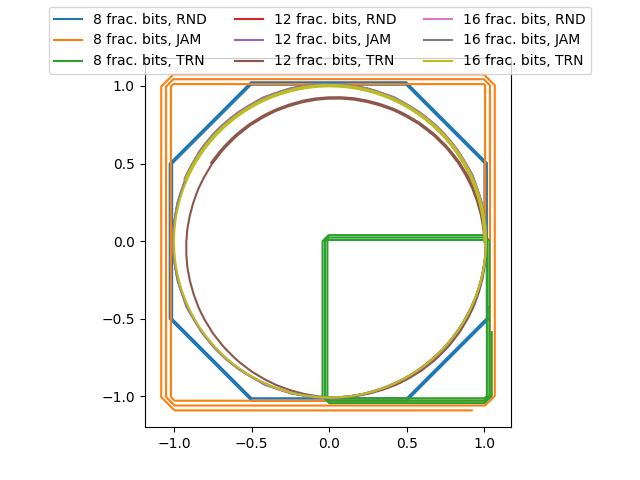Note
Go to the end to download the full example code.
Fixed-point vector rotation¶
This illustrates the effect of performing a vector rotation using different number of fractional bits and different quantization schemes.

8 fractional bits. Gain: 1.0000076293654276. Angle: 0.0039062301319669718.
12 fractional bits. Gain: 1.0000042915252152. Angle: 0.0029296791181399936.
16 fractional bits. Gain: 1.000004517952019. Angle: 0.003005972391421174.
import math
import matplotlib.pyplot as plt
import numpy as np
import apytypes as apy
angle = 0.003
def print_rotation_properties(angle, frac_bits) -> None:
cosa = math.cos(angle)
sina = math.sin(angle)
rotation_matrix = apy.fx([[cosa, -sina], [sina, cosa]], 2, frac_bits)
rm = rotation_matrix.to_numpy()
print(
f"{frac_bits} fractional bits. Gain: {np.hypot(*rm[0, :])}. Angle: {np.arctan2(*rm[1, :])}."
)
def rotate(angle, frac_bits, iterations, quantization):
results = apy.zeros((iterations + 1, 2), int_bits=2, frac_bits=frac_bits)
cosa = math.cos(angle)
sina = math.sin(angle)
rotation_matrix = apy.fx([[cosa, -sina], [sina, cosa]], 2, frac_bits)
current_value = apy.fx([1, 0], 2, frac_bits)
results[0, :] = current_value.T
for i in range(iterations):
tmp_res = rotation_matrix @ current_value
current_value = tmp_res.cast(2, frac_bits, quantization)
results[i + 1, :] = current_value.T
return results
fig, ax = plt.subplots()
for frac_bits in (8, 12, 16):
print_rotation_properties(angle, frac_bits)
for quantization in (
"RND",
"JAM",
"TRN",
):
results = rotate(
angle, frac_bits, 3000, eval(f"apy.QuantizationMode.{quantization}")
)
ax.plot(
results[:, 0],
results[:, 1],
label=f"{frac_bits} frac. bits, {quantization}",
)
ax.set_aspect("equal")
fig.legend(ncols=3, loc="upper center")
plt.show()
Total running time of the script: (0 minutes 0.142 seconds)